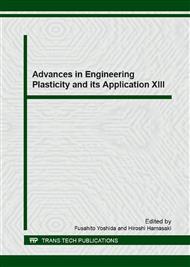p.41
p.47
p.55
p.60
p.66
p.72
p.77
p.82
p.88
A Computational Investigation on Small Punch Test for Evaluating Fracture Toughness of TRIP Steel at Higher Deformation Rate
Abstract:
It is considered that fracture toughness of TRIP steel can be evaluated by means of the small punch (SP) test. However, a mechanism of improving fracture toughness in the SP test for TRIP steel under the impact condition might not be clarified through merely experimental works because the effect of strain-induced martensitic transformation (SIMT) coupled with temperature in TRIP steel becomes quite complicated at high deformation rate. Therefore, a computational simulation on the SP test for an evaluation of the mechanism is indispensable. Since the specimen in the SP test will be fractured at a certain level of deformation, it is necessary to express the fracture by incorporating damage model into constitutive equation of the material in simulation of the SP test. In the present study, a finite element analysis is performed for the SP test with a specimen made of type-304 austenitic stainless steel by an inclusion of damage parameter and its evolution equation. After showing the validity of the computation, the effects of deformation rate, temperature, and SIMT on the force-deflection curve and deformation behavior are examined. Then, the mechanism of rate-sensitive fracture toughness in TRIP steel is challenged to be clarified.
Info:
Periodical:
Pages:
66-71
Citation:
Online since:
December 2016
Authors:
Keywords:
Price:
Сopyright:
© 2017 Trans Tech Publications Ltd. All Rights Reserved
Share:
Citation:


